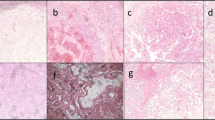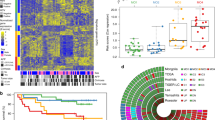Abstract
Genomic analysis of hepatocellular carcinoma (HCC) has been shown to provide clues about local risk factors. In the last decades, the mortality from malignant liver tumors increased sharply in Romania, where both hepatitis viruses and environmental pollutants are known to be highly prevalent. To date, HCC from this country has not been subject to molecular characterization. We analyzed a series of 48 consecutive HCC cases. Point mutations were searched in 9 nuclear genes and the mitochondrial D-loop. Oxidative stress response was monitored through measurement of gene expression (NRF2, KEAP1, SRXN1, and CES1) by qRT-PCR. An atypical mutation spectrum was observed, as more than 40% of DNA changes were oxidative stress-associated T>C or T>G lesions (T>S). These mutations affected primarily genes encoding for β-catenin and NRF2 (P<0.0001). Besides, tumors from patients born in Greater Bucharest carried TP53 mutations more frequently than others (45 vs 10%, P=0.02). Finally, a R249S mutation of TP53, well-known hallmark of aflatoxin B1 exposure, was found. Our findings indicate, therefore, that distinct mutagenic processes affect Romanian patients with HCC. Further analyses are now warranted in order to identify causal lifestyle or environmental factors.
This is a preview of subscription content, access via your institution
Access options
Subscribe to this journal
Receive 6 print issues and online access
$259.00 per year
only $43.17 per issue
Buy this article
- Purchase on Springer Link
- Instant access to full article PDF
Prices may be subject to local taxes which are calculated during checkout





Similar content being viewed by others
References
El-Serag H . Epidemiology of viral hepatitis and hepatocellular carcinoma. Gastroenterology 2012; 142: 1264–1273.
Dragani T . Risk of HCC: genetic heterogeneity and complex genetics. J Hepatol 2010; 52: 252–257.
McGlynn K, London W . Epidemiology and natural history of hepatocellular carcinoma. Best Pract Res Clin Gastroenterol 2005; 19: 3–23.
Van Thiel D, Ramadori G . Non-viral causes of hepatocellular carcinoma. J Gastrointest Cancer 2011; 42: 191–194.
Guichard C, Amaddeo G, Imbeaud S, Ladeiro Y, Pelletier L, Maad I et al. Integrated analysis of somatic mutations and focal copy-number changes identifies key genes and pathways in hepatocellular carcinoma. Nat Genet 2012; 44: 694–698.
Pineau P, Marchio A, Battiston C, Cordina E, Russo A, Terris B et al. In human hepatocellular carcinoma, chromosome instability depends on p53 status and aflatoxin exposure. Mutat Res 2008; 653: 6–13.
Boffetta P, Nyberg F . Contribution of environmental factors to cancer risk. Br Med Bull 2003; 68: 71–94.
Wild C . Complementing the genome with an ''exposome'': the outstanding challenge of environmental exposure measurement in molecular epidemiology. Cancer Epidemiol Biomarkers Prev 2005; 14: 1847–1850.
Esteban J, Sauleda S, Quer J . The changing epidemiology of hepatitis C virus infection in Europe. J Hepatol 2008; 48: 148–162.
Nardone A, Anastassopoulou C, Theeten H, Kriz B, Davidkin I, Thierfelder W et al. A comparison of hepatitis B seroepidemiology in ten European countries. Epidemiol Infect 2009; 137: 961–969.
Dirtu A, Cernat R, Dragan D, Mocanu R, Van Grieken R, Neels H et al. Organohalogenated pollutants in human serum from Iassy, Romania and their relation with age and gender. Environ Int 2006; 32: 797–803.
Farmer P, Singh R, Kaur B, Sram R, Binkova B, Kalina I et al. Molecular epidemiology studies of carcinogenic environmental pollutants. Effects of polycyclic aromatic hydrocarbons (PAHs) in environmental pollution on exogenous and oxidative DNA damage. Mutat Res 2003; 544: 397–402.
Flora S . Arsenic-induced oxidative stress and its reversibility. Free Radic Biol Med 2011; 51: 254–281.
Jedrychowski W, Maugeri U, Bianchi I . Environmental pollution in central and eastern European countries: a basis for cancer epidemiology. Rev Environ Health 1997; 12: 1–23.
Lindberg A, Goessler W, Gurzau E, Koppova K, Rudnai P, Kumar R et al. Arsenic exposure in Hungary, Romania and Slovakia. J Environ Monit 2006; 8: 203–208.
Váli L, Hahn O, Kupcsulik P, Drahos A, Sárváry E, Szentmihály i.K et al. Oxidative stress with altered element content and decreased ATP level of erythrocytes in hepatocellular carcinoma and colorectal liver metastases. Eur J Gastroenterol Hepatol 2008; 20: 393–398.
Ribes J, Clèries R, Esteban L, Moreno M, Bosch F . The influence of alcohol consumption and hepatitis B and C infections on the risk of liver cancer in Europe. J Hepatol 2008; 49: 233–242.
Valean S, Armean P, Resteman S, Nagy G, Mureşan A, Mircea P . Cancer mortality in Romania, 1955-2004. Digestive sites: esophagus, stomach, colon and rectum, pancreas, liver, gallbladder and biliary tree. J Gastrointestin Liver Dis 2008; 17: 9–14.
Lee H, Li S, Lin J, Wu C, Yeh D, Wei Y . Somatic mutations in the D-loop and decrease in the copy number of mitochondrial DNA in human hepatocellular carcinoma. Mutat Res 2004; 547: 71–78.
Marchio A, Akil A, Terris B, Dejean A, Pineau P . Insertion/deletion polymorphisms are convenient and reliable markers to assess chromosomal instability in human tumors. Int J Biol Markers 2012; 27: e232–e240.
Kim M, Clinger J, Masayesva B, Ha P, Zahurak M, Westra W et al. Mitochondrial DNA quantity increases with histopathologic grade in premalignant and malignant head and neck lesions. Clin Cancer Res 2004; 10: 8512–8515.
Li C, Wong W . Model-based analysis of oligonucleotide arrays: expression index computation and outlier detection. Proc Natl Acad Sci USA 2001; 98: 31–36.
Barbin A . Etheno-adduct-forming chemicals: from mutagenicity testing to tumor mutation spectra. Mutat Res 2000; 462: 55–69.
Olinski R, Gackowski D, Rozalski R, Foksinski M, Bialkowski K . Oxidative DNA damage in cancer patients: a cause or a consequence of the disease development? Mutat Res 2003; 531: 177–190.
Yin P, Lee H, Chau G, Wu Y, Li S, Lui W et al. Alteration of the copy number and deletion of mitochondrial DNA in human hepatocellular carcinoma. Br J Cancer 2004; 90: 2390–2396.
Vivekanandan P, Daniel H, Yeh M, Torbenson M . Mitochondrial mutations in hepatocellular carcinomas and fibrolamellar carcinomas. Mod Pathol 2010; 23: 790–798.
Mansouri A, Fromenty B, Berson A, Robin M, Grimbert S, Beaugrand M et al. Multiple hepatic mitochondrial DNA deletions suggest premature oxidative aging in alcoholic patients. J Hepatol 1997; 27: 96–102.
Kensler T, Wakabayashi N, Biswal S . Cell survival responses to environmental stresses via the Keap1-Nrf2-ARE pathway. Annu Rev Pharmacol Toxicol 2007; 47: 89–116.
Kim Y, Lee H, Lee K, Park J, Chung W, Lee K et al. Nuclear factor E2-related factor 2 dependent overexpression of sulfiredoxin and peroxiredoxin III in human lung cancer. Korean J Intern Med 2011; 26: 304–313.
Nguyen T, Nioi P, Pickett C . The Nrf2-antioxidant response element signaling pathway and its activation by oxidative stress. J Biol Chem 2009; 284: 13291–13295.
Grigorescu M, Pascu O, Acalovschi M, Radu C . What is the real prevalence of the D virus infection in chronic hepatitis and liver cirrhosis in Romania? Rom J Gastroenterol 2003; 12: 179–182.
Boffetta P, Kaihovaara P, Rudnai P, Znaor A, Lissowska J, Swiatkowska B et al. Acetaldehyde level in spirits from central European countries. Eur J Cancer Prev 2011; 20: 526–529.
Lachenmeier D, Ganss S, Rychlak B, Rehm J, Sulkowska U, Skiba M et al. Association between quality of cheap and unrecorded alcohol products and public health consequences in Poland. Alcohol Clin Exp Res 2009; 33: 1757–1769.
Lachenmeier D, Schoeberl K, Kanteres F, Kuballa T, Sohnius E, Rehm J, Alcohol Measures for Public Health Research Alliance. Is contaminated unrecorded alcohol a health problem in the European Union? A review of existing and methodological outline for future studies. Addiction 2011; 106 (Suppl 1): 20–30.
Lachenmeier D, Przybylski M, Rehm J . Comparative risk assessment of carcinogens in alcoholic beverages using the margin of exposure approach. Int J Cancer 2012; 131: E995–1003.
Leonardi G, Vahter M, Clemens F, Goessler W, Gurzau E, Hemminki K et al. Inorganic arsenic and basal cell carcinoma in areas of Hungary, Romania, and Slovakia: a case-control study. Environ Health Perspect 2012; 120: 721–726.
Tabuc C, Marin D, Guerre P, Sesan T, Bailly J . Molds and mycotoxin content of cereals in southeastern Romania. J Food Protec 2009; 72: 662–665.
Fuks D, Dokmak S, Paradis V, Diouf M, Durand F, Belghiti J . Benefit of initial resection of hepatocellular carcinoma followed by transplantation in case of recurrence: an intention-to-treat analysis. Hepatology 2012; 55: 132–140.
Hussain S, Schwank J, Staib F, Wang X, Harris C . TP53 mutations and hepatocellular carcinoma: insights into the etiology and pathogenesis of liver cancer. Oncogene 2007; 26: 2166–2176.
Curtui V, Usleber E, Dietrich R, Lepschy J, Märtlbauer E . A survey on the occurrence of mycotoxins in wheat and maize from western Romania. Mycopathologia 1998; 143: 97–103.
Wild C, Gong Y . Mycotoxins and human disease: a largely ignored global health issue. Carcinogenesis 2010; 31: 71–82.
Peptenatu D, Pintilii R, Draghici C, Stoian D . Environmental pollution in functionally restructured urban areas: case study, the city of Bucharest. Iran J Environ Health Sci Eng 2010; 7: 87–96.
Kim Y, Park C, Kim H, Choi S, Rew J, Kim D et al. Genetic alterations of Wnt signaling pathway-associated genes in hepatocellular carcinoma. J Gastroenterol Hepatol 2008; 23: 110–118.
Chiu H, Ho S, Wang L, Wu T, Yang C . Does arsenic exposure increase the risk for liver cancer? J Toxicol Environ Health A 2004; 67: 1491–1500.
Forkert P . Mechanisms of lung tumorigenesis by ethyl carbamate and vinyl carbamate. Drug Metab Rev 2010; 42: 355–378.
Satou K, Kawai K, Kasai H, Harashima H, Kamiya H . Mutagenic effects of 8-hydroxy-dGTP in live mammalian cells. Free Radic Biol Med 2007; 42: 1552–1560.
Hori M, Satou K, Harashima H, Kamiya H . Suppression of mutagenesis by 8-hydroxy-2'-deoxyguanosine 5'-triphosphate (7,8-dihydro-8-oxo-2'-deoxyguanosine 5'-triphosphate) by human MTH1, MTH2, and NUDT5. Free Radic Biol Med 2010; 48: 1197–1201.
Slocum S, Kensler T . Nrf2: control of sensitivity to carcinogens. Arch Toxicol 2011; 85: 273–284.
Lehwald N, Tao G, Jang K, Sorkin M, Knoefel W, Sylvester K . Wnt-β-catenin signaling protects against hepatic ischemia and reperfusion injury in mice. Gastroenterology 2011; 141: 707–718.
Zhang X, Tan X, Zeng G, Misse A, Singh S, Kim Y et al. Conditional beta-catenin loss in mice promotes chemical hepatocarcinogenesis: role of oxidative stress and platelet-derived growth factor receptor alpha/phosphoinositide 3-kinase signaling. Hepatology 2010; 52: 954–965.
Wild C . The exposome: from concept to utility. Int J Epidemiol 2012; 41: 24–32.
Acknowledgements
We are grateful to the Plate-forme Génomique no. 1 of the Institut Pasteur (Sylviane Bouchier and Catherine Gouyette). We thank Kathleen Victoir and Marc Jouan for their support. We feel greatly indebted to Camille Baron for her help in setting up the protocol document and the case report form. We thank Jacob Seeler for critical reading of the manuscript. This work, part of the ACIP2006 (Action Concertée Interpasteurienne), was funded by the Division International of the Institut Pasteur and by the French National League against Cancer (LNCC).
Author information
Authors and Affiliations
Corresponding author
Ethics declarations
Competing interests
The authors declare no conflict of interest.
Additional information
Supplementary Information accompanies the paper on the Journal of Exposure Science and Environmental Epidemiology website
Rights and permissions
About this article
Cite this article
Tanase, AM., Marchio, A., Dumitrascu, T. et al. Mutation spectrum of hepatocellular carcinoma from eastern-European patients betrays the impact of a complex exposome. J Expo Sci Environ Epidemiol 25, 256–263 (2015). https://doi.org/10.1038/jes.2014.16
Received:
Revised:
Accepted:
Published:
Issue Date:
DOI: https://doi.org/10.1038/jes.2014.16
This article is cited by
-
A Scoping Review on the Characteristics of Human Exposome Studies
Current Pollution Reports (2019)
-
Droplet digital PCR detects high rate of TP53 R249S mutants in cell-free DNA of middle African patients with hepatocellular carcinoma
Clinical and Experimental Medicine (2018)
-
Activating de novo mutations in NFE2L2 encoding NRF2 cause a multisystem disorder
Nature Communications (2017)
-
Association of Nrf2 with airway pathogenesis: lessons learned from genetic mouse models
Archives of Toxicology (2015)



